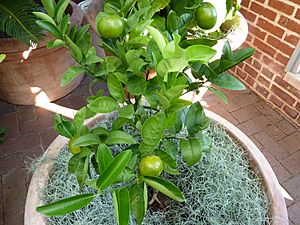Murcott (fruit) facts for kids
Quick facts for kids Murcott |
|
|---|---|

Citrus x nobilis 'W. Murcott', in the Linnean House of the Missouri Botanical Garden
|
|
| Hybrid parentage | Parents unknown; likely a tangor |
| Cultivar | Murcott |
| Marketing names | 'Honey tangerine' |
| Origin | Florida |
The Murcott is a popular type of citrus fruit. It's often sold as the "Honey Tangerine" because of its sweet taste. This fruit is a tangor, which means it's a natural mix, or hybrid, of a mandarin orange and a sweet orange.
Contents
What is the Murcott Fruit?
The Murcott is a special kind of citrus fruit. It's known for being very sweet and juicy. People often call it the Honey Tangerine. It's a cross between two other citrus fruits.
How Was the Murcott Created?
The Murcott fruit came about because of a scientist named Walter Tennyson Swingle. He was a "citrus pioneer" who worked with citrus plants. He tried to create new and interesting fruit types. Around 1913, he made a new hybrid tree. He gave it to R. D. Hoyt in Safety Harbor, Florida.
Hoyt then shared parts of the tree, called "budwood," with his nephew, Charles Murcott Smith. This is how the fruit got its name, "Murcott." By 1922, Smith was growing these trees in his nursery in Florida.
What Does a Murcott Tree Look Like?
Murcott trees usually grow straight up. However, their branches can sometimes bend or even break. This happens when the tree produces a lot of fruit. The heavy fruit at the ends of the branches can weigh them down.
Where Do Murcotts Grow?
Murcott fruits are grown a lot in Florida, in the United States. They are ready to be picked from January to March. This is when the fruit is ripe and tastes its best.
What Problems Do Murcott Trees Face?
Like many plants, Murcott trees can get sick. Two common problems are citrus scab and alternaria fungus disease. Citrus scab causes rough spots on the fruit and leaves. Alternaria fungus can also damage the fruit and leaves. Farmers work to protect the trees from these diseases.
Related Citrus Fruits
The Murcott is also a parent of another popular citrus fruit. This fruit is a Clementine-like hybrid. It is known by different names, such as Afourer, Nadorcott, or W. Murcott. The other parent of this hybrid is not known.


